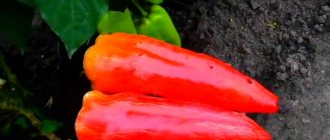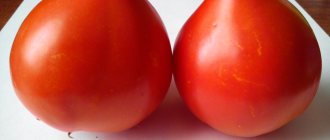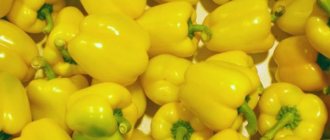| Ripening period: | mid-early |
| Shape, weight of fruits: | cylindrical, 250-300 g |
| Bush type: | determinant |
| Growing regions: | everywhere |
| Productivity: | under the film - 12.8 kg per sq. m |
Sweet thick-walled pepper Livadia is one of the best new products on the domestic market, worthy of the attention of farmers and amateur vegetable growers. It does not require special care and produces a high yield when grown in the garden and in protected ground. The fruits are beautiful, very tasty when consumed fresh, but fully reveal their aroma after heat treatment.
Characteristics of the hybrid and description of the fruits
Sweet pepper Livadia is a hybrid registered by the general director of agro V.I. Blokin-Mechtalin. Accepted by the State Register in 2019, recommended for cultivation in all regions of the Russian Federation.
Description of the bush
Forms a powerful bush, spreading, with a large number of dark green leaves. Without blinding skeletal shoots in greenhouses it reaches a height of 1.4-1.5 m; for open ground the dimensions are more modest. But since this is a large-fruited hybrid, it is not allowed to grow even up to a meter. The stems mature after the appearance of 8 ovaries.
Fruit characteristics
Livadia's peppers, as can be seen in the photo, have their noses down and are prismatic or cylindrical in shape. They have pronounced edges that clearly indicate 3 or 4 chambers, often flattened on the sides. The first, largest fruits are often deformed and have a bizarre but attractive shape.
The color of peppers at the technical stage is dark green. When removed, red strokes appear on the surface; when fully ripe, the fruits become shiny and burgundy.
Livadia gains a stated weight of 250-300 g and a wall thickness of 7-9 (up to 10) mm if 8 peppers are left on the bush. With 15 ovaries, the weight of the fruit will decrease proportionally. When the plant is allowed to reach its maximum height, they become the size of a regular bell pepper.
The total weight of the harvest from the bush does not change; 5, 15 or 25 ovaries will be left on it. The size and weight of an individual fruit will vary.
Collecting seeds is useless. Livadia is a hybrid; plants grown from their own planting material do not inherit varietal characteristics.
Taste, quality, use of fruits
Livadia's taste and aroma will be especially rich, and the wall thickness can exceed 1 cm if the peppers are allowed to fully ripen on the bush. But they are removed so as not to interfere with the ripening of the upper fruits, usually after the first red marks appear.
The skin of Livadia is dense, the pulp contains a lot of fiber. The fruits can even be called harsh when consumed fresh, but they remain juicy. After heat treatment, peppers fully reveal their aroma. In lecho, when baked in the oven or on the grill, the “meat” does not become like rags and remains elastic.
Livadia fruits ripen well indoors, are well transported and last a long time without losing their consumer and commercial qualities.
Fruiting time and yield
Pepper variety Livadia - medium ripening. It acquires removable ripeness 75-80 days after planting the seedlings. About 60 more days should pass from the moment the seeds hatch.
Productivity, kg/sq.m.:
- greenhouses – 14;
- film tunnels – 12.8;
- open ground – 8 and above.
Pros and cons of the variety
| pros | Minuses |
| Pleasant sweet taste | Need to form a bush |
| Low maintenance | Cannot be grown from seeds taken from fruits |
| Easily transports over long distances | |
| Big fruits | |
| Easy to care for adult plants | Characteristic |
| They ripen quietly on windowsills until they reach final maturity. | |
| After cooking, its unique taste is revealed |
Planting dates and care features
Pepper Livadia F1 is sown as seedlings approximately 2.5-3 months before moving to a permanent location. The exact timing depends on the region and long-term weather forecast.
Pepper seeds hatch with difficulty and take a long time; for Livadia it takes about 15 days. You should add a few days for preparation:
- warming up;
- pickling;
- soaking until swelling.
It is strictly not recommended to germinate seeds. The root of peppers is fragile and is the first to hatch. If it breaks when transplanted into the ground, nothing will grow from the seed.
Sowing dates can only be indicated approximately, for greenhouses:
- south - from late January to early February;
- Volga region - late February and early March;
- center, North-West, Urals - mid and end of March;
- Siberia and the Far East - from late March to early April.
For open ground, the time is shifted forward by 2 weeks. After pecking the seedlings:
- the seedlings are transferred to a cool room for 5-7 days, then kept at 22-25 ° C;
- provide bright illumination for 10 hours;
- Water regularly and evenly, avoiding waterlogging or drying out;
- in the phase of 1-2 true leaves they dive;
- after 2 weeks they begin to feed with complex fertilizers with a predominance of nitrogen;
- 10-14 days before moving into the ground they are hardened.
Plant seedlings without deepening the stem when the ground warms up:
- for growing in the garden - at least up to 15° C;
- in greenhouses – up to 10° C.
Caring for a Livadia hybrid is no more difficult than caring for varietal peppers:
- 2 weeks after planting they give a mineral complex, focusing on potassium;
- water evenly and moderately;
- form a bush with 2 trunks;
- skeletal shoots are blinded when 8 ovaries extend;
- The fruits are removed after the first red marks appear.
Reviews
Dmitry from Krasnodar region. Last year, a neighbor in the country “treated” the seedlings of a new hybrid. The pepper took off well and quickly began to grow. As a result, I got lush bushes with a lot of buds. I left 8 flowers on each one. The peppers turned out large and meaty. The largest tightened it to 380 g.
Valentina from Voronezh. I grow peppers in a greenhouse for sale. I liked the presented hybrid because of its large, bright fruits. There is no more trouble with it than with other varieties. The only caveat is that it requires more “food”.
Pepper Livadia F1 is a modern variety that is suitable for growing in any conditions. At the same time, even a novice gardener can master simple agricultural techniques and get a significant harvest.
Similar hybrids
Thick-walled, large-fruited hybrids are similar to Livadia:
- Aries F1. Mid-season, in greenhouses grows up to 1.4 m. The fruits are deep red, elongated-prismatic, weighing 300 g, with a wall of about 7 mm. S m sq. harvest up to 14 kg.
- Lamuyo. Tall, early-ripening hybrid with trapezoidal dark red fruits weighing 200-250 g, wall 7-8 mm. Resistant to a number of diseases. Gives 12 kg per sq. m.
- Partner F Medium ripening period, 1.2-1.4 m high. The fruits are very similar to Livadia in appearance and other characteristics, but shorter, thicker-walled. Weight – 190-220 g, pericarp – 1.2 cm. Productivity per 1 sq. m: open ground – 8 kg, greenhouses – 14 kg.
The characteristics and description of the Livadia hybrid allow us to consider it one of the best modern sweet peppers. The combination of productivity, ease of care, beautiful large fruits with excellent taste made it extremely popular immediately after the seeds went on sale.
Characteristics of the variety
| Parameter | Characteristic |
| Variety | Livadia (lat. Livadiya) |
| Description of fruits | The fruits are cone-shaped and have symmetrically concave hollows on all sides. Larger and heavier fruits do not differ in taste from smaller ones. The peel is red, dense, with “fleshy” pulp. |
| Pepper mass | The average fruit weight is 200-300 g, in greenhouse conditions it can reach 250-350 g |
| Color | The skin of ripe fruits is dark red in color, with a large number of seeds inside. |
| Form | Cone-shaped |
| Pepper size | Length up to 15-18, diameter - up to 10 cm |
| Wall thickness | The wall thickness at the stage of technical maturity is 6-8 mm, for ripe fruits - up to 9-10 mm |
| Taste of the fruit | Sweet and juicy |
| Productivity | from 13 kg per 1 m² in a greenhouse, in open ground up to 8 kg per 1 m² |
| Maturation speed | From 70-80 days the fruits reach ripeness, mid-ripening variety |
| Bush height | The bush is powerful and strong, up to 140 cm high, requires pinching to increase productivity |
| Pollination type | Self-pollinating |
| Nestedness | From 3-4 nests |
| Type of ovary formation | Bouquet type ovaries. Female flowers are solitary with an inferior ovary and significantly predominate in number. Rare male flowers are collected in racemose inflorescences. |
| Transportability and keeping quality | good |
| Resistance to adverse conditions | The variety is quite resistant to aggressive environmental influences, however, with prolonged exposure to low temperatures, there may be a delay in the development of the plant and a stop in the formation of ovaries. |
| Resistance to diseases and pests | Resistant to infection by tobacco mosaic virus |
| Should I dive? | After germination, the seedlings are sown in a permanent place where the plant grows. |
| Recommended growing regions | All regions |
| Year of inclusion in the State Register of the Russian Federation | 2019 |
| Originator | FSBEI HE RGAU-MSHA named after. K.A. Timiryazev |
Choosing a landing site
Peppers of the Livadia variety feel good in a place where there is a lot of light and no drafts.
Therefore, plants are planted where there is no wind and there is no darkness.
A caring summer resident should also take care of the soil. It should be:
- fertile;
- with neutral acidity;
- do not retain water.
Before planting Livadia sweet peppers, the soil should be spilled with a solution of copper sulfate and dug up. Experienced farmers also apply complex fertilizer. Then they dig holes at a distance of 55–60 cm, and maintain the same distance between the beds. The holes are thoroughly watered.
That is, it turns out that no more than 3-4 bushes are planted per 1 m2. For tall peppers, the use of this planting scheme is considered the most successful option.
Proper cultivation
Like any plant, Livadia pepper has its own subtleties of proper cultivation. In particular, it is recommended to grow only by seedlings; seeds are not planted in open ground. Let us dwell in more detail on how to properly grow a hybrid.
We talked in detail about the secrets of growing peppers in the garden and in the greenhouse in a separate article.
Preparing and planting seeds
Inventory
You will need to prepare the planting material itself, separate containers for planting or ready-made peat tablets, soil and warm water for irrigation.
Priming
The Livadia variety is not too demanding on soil quality; ordinary garden soil is quite suitable. But it should be nutritious, loose and neutrally acidic. It can be poured with boiling water or treated with slightly diluted potassium permanganate.
Seed preparation
- The planting material is filled with water at room temperature for 60 minutes. Seeds that rise up for planting are not suitable and must be removed.
- High-quality specimens must be placed in a weak solution of potassium permanganate to disinfect them.
- Disinfected seeds must be additionally treated with a growth stimulating drug.
- The prepared grains are placed in a wide container and covered with a moistened cloth. The container should be kept warm, and it is important to maintain constant humidity. Once the roots appear, they can be planted in containers.
Read more about how to prepare seeds and when to plant pepper seedlings here.
Landing technology
- When planting seeds in ready-made tablets, you should place 2 seeds in each of them; as they germinate, the weaker specimen can be removed.
- The container with seeds must be covered with film or glass, this will create a greenhouse effect.
- The optimal temperature should be maintained at 25-30 degrees. This will allow you to get the first shoots within 14 days.
- As soon as a couple of true leaves appear, the seedlings can be transplanted into larger containers.
When planting grown seedlings in a greenhouse or open ground, it is necessary to take into account that you should not place more than 3-4 bushes per m2.
The distance between the holes in both directions should be from 50 to 60 centimeters. Then each bush will have enough space to grow. It is important to choose a site that is not exposed to strong winds and has sufficient lighting.
Features of care
Watering
Young seedlings need moderate watering with warm water. The soil should not be too wet or too dry. Water should be applied directly to the root.
Loosening
The soil must allow sufficient oxygen to pass through to the root system, so regular loosening is necessary.
Tying up
Livadia pepper bushes are quite tall, so as they grow they will need staking, which will help avoid the bushes from falling over. To do this, you can use sticks or arcs.
Top dressing
Even before planting, complex fertilizer is applied to the soil. In addition, fertilizing will need to be applied 3 more times during the growing season. The composition of fertilizers will depend on the timing and stage of development of seedlings.
| Pepper seedling growth phase | Recommended Fertilizer |
| 14 days after planting in the ground | Superphosphate and calcium nitrate |
| Flowering time | Potassium monophosphate |
| Period of ovary formation | Potassium salt and superphosphate |
In addition, it is necessary to avoid drafts and pick up seedlings in time.











